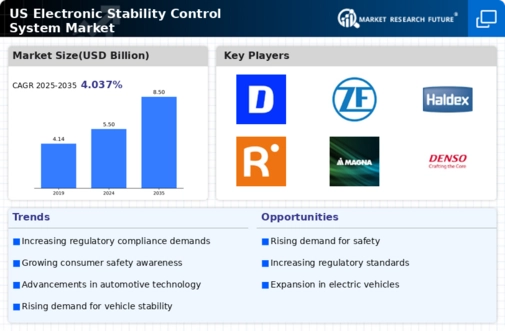Rising Incidence of Road Accidents
the increasing incidence of road accidents in the US drives the electronic stability-control-system market. Statistics reveal that road accidents have been a leading cause of fatalities, prompting both consumers and manufacturers to prioritize safety features in vehicles. The implementation of electronic stability control systems has been shown to reduce the risk of rollovers and loss of control, which are common factors in many accidents. As awareness of these benefits grows, it is anticipated that the adoption of ESC systems will continue to rise. In 2025, it is projected that the market will expand as more states consider legislation to mandate the inclusion of electronic stability control in all new vehicles, further propelling the electronic stability-control-system market.
Increasing Vehicle Safety Standards
the electronic stability-control-system market is growing due to the rising vehicle safety standards mandated by regulatory bodies in the US. These standards are designed to reduce accidents and enhance vehicle stability, leading to a higher adoption rate of electronic stability control (ESC) systems. As of 2025, it is estimated that nearly 90% of new vehicles sold in the US are equipped with ESC systems, reflecting a significant increase from previous years. This trend indicates a strong commitment to improving road safety, which is likely to drive demand for advanced electronic stability-control systems. Furthermore, manufacturers are investing in research and development to meet these stringent safety requirements, thereby propelling the electronic stability-control-system market forward.
Technological Integration in Vehicles
the integration of advanced technologies in vehicles drives the electronic stability-control-system market. Innovations such as artificial intelligence, machine learning, and advanced sensor technologies are being incorporated into ESC systems to enhance their performance. For instance, the use of real-time data analytics allows for better prediction of vehicle behavior under various driving conditions. As of 2025, the market for advanced driver-assistance systems (ADAS), which includes electronic stability control, is projected to reach $30 billion in the US. This growth suggests that consumers are increasingly seeking vehicles equipped with sophisticated safety features, thereby boosting the demand for electronic stability-control systems.
Government Incentives for Safety Technologies
Government incentives aimed at promoting safety technologies are playing a crucial role in the growth of the electronic stability-control-system market. Various federal and state programs offer financial incentives for manufacturers to develop and implement advanced safety features, including electronic stability control systems. These initiatives not only encourage innovation but also make it more feasible for consumers to access vehicles equipped with such technologies. As of 2025, it is estimated that these incentives could lead to a 15% increase in the adoption rate of electronic stability control systems among new vehicles. This supportive regulatory environment is likely to foster a more competitive market landscape, driving further advancements in the electronic stability-control-system market.
Consumer Demand for Enhanced Driving Experience
Consumer preferences are shifting towards vehicles that offer enhanced driving experiences, which is positively impacting the electronic stability-control-system market. As drivers become more aware of the benefits of stability control, such as improved handling and reduced skidding, the demand for these systems is likely to increase. Surveys indicate that approximately 70% of consumers prioritize safety features when purchasing a vehicle, which includes electronic stability control. This growing consumer awareness is prompting manufacturers to incorporate ESC systems as standard features in new models, thereby driving the electronic stability-control-system market. The emphasis on a safer and more enjoyable driving experience is expected to sustain market growth in the coming years.




















Leave a Comment